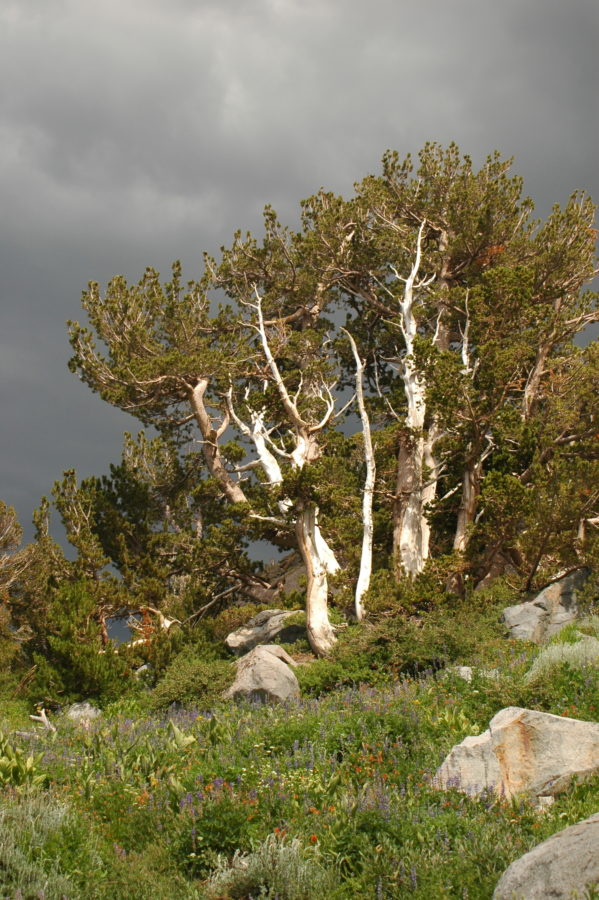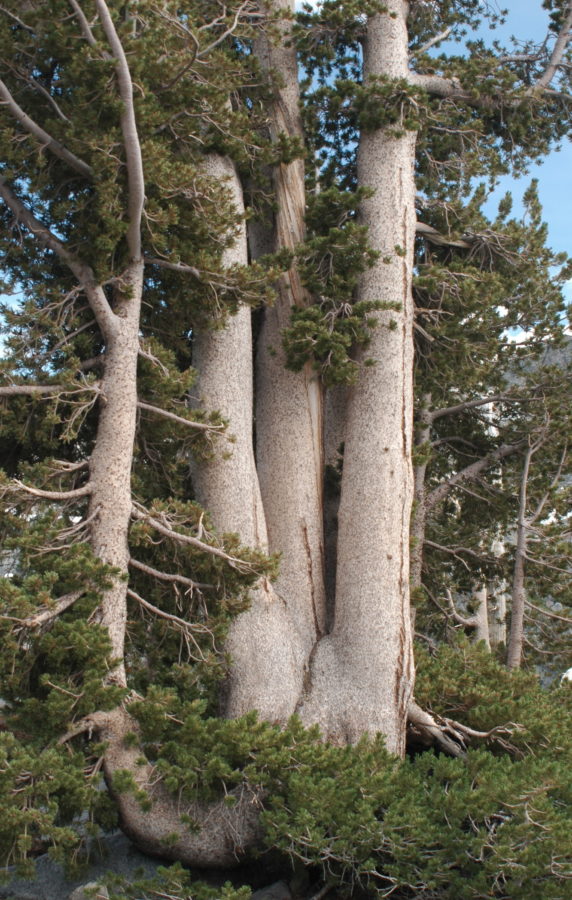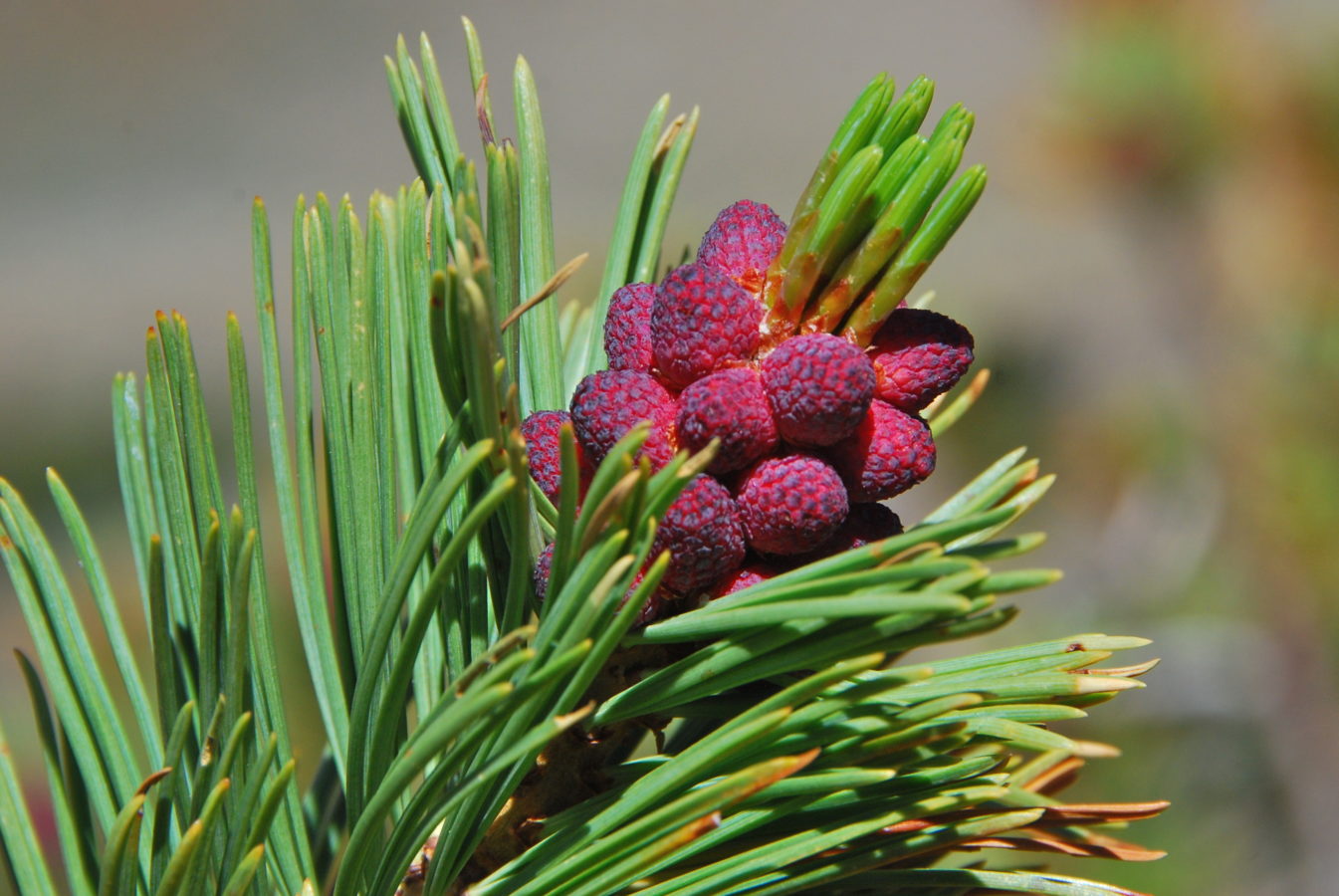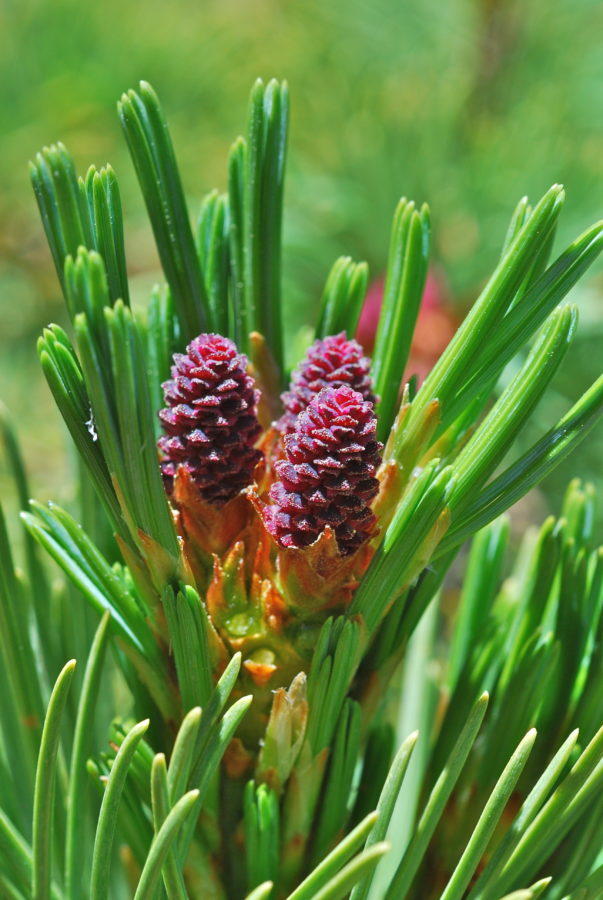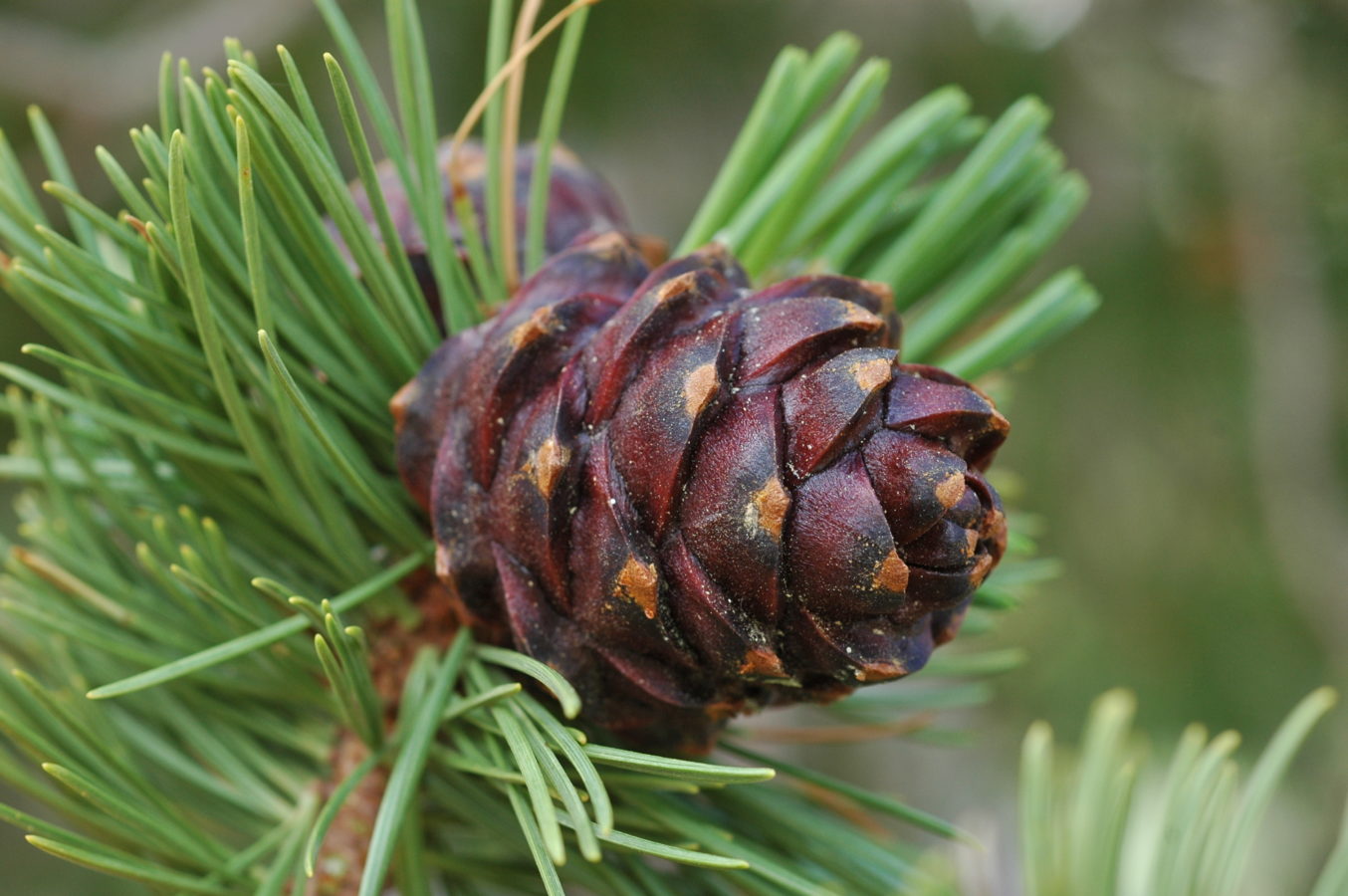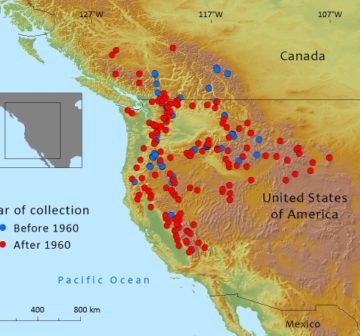Pinaceae
Pinus albicaulis
Native to Western USA and Canada where historically large areas of forests were lost to the mining industry; today it is threatened by wildfire, White Pine Blister Rust and Mountain Pine Beetle
Human Uses
Between 1860 to 1940, billions of board feet of whitebark pine were cut to support the Montana mining industry; the wood was used for fuelwood in smelters and to heat miner‘s homes; now less than 1000 acres in the United States are harvested each year, typically within a timber sale for lodgepole pine (Losensky, 1990).
References and further reading
- Arno, S. F. & Weaver, T. (1990). Whitebark pine community types and their patterns on the landscape. In: Schmidt, W.C.; McDonald, K.J. (ed.), Whitebark pine ecosystems—Ecology and management of a high mountain resource, pp. 97-105. March 29-31, 1989, Bozeman, MT.
- Arno, S.F. & Hoff, R.J. (1990). Pinus albicaulis Englem. In: Burns, R.M.; Honkala, B.H. (ed.), Silvics of North America, Agriculture Handbook 654, pp. 268-279. USDA Forest Service, Washington, DC.
- Aubry, C., Goheen, D., Shoal, R., Ohlson, T., Lorenz, T., Bower, A., Mehmel, C., Sniezko, R.A. (2008). Whitebark pine restoration strategy for the Pacific Northwest 2009-2013. Region 6 Report. U.S. Department of Agriculture, Forest Service, Pacific Northwest Region, Portland, OR.
- COSEWIC (Committee on the Status of Endangered Wildlife in Canada). (2010). COSEWIC assessment and status report on the Whitebark Pine Pinus albicaulis in Canada. Committee on the Status of Endangered Wildlife in Canada, Ottawa.
- Felicetti, L.A., Schwartz, C.C., Rye, R.O., Haroldson, M.A., Gunther, K.A., Phillips, D.L., Robbins, C.T. (2003). Use of sulfur and nitrogen stable isotopes to determine the importance of whitebark pine nuts to Yellowstone grizzly bears. Canadian Journal of Zoology 81(5): 763-770.
- Forcella, F. (1977). Flora, chorology, biomass and productivy of the Pinus albicaulis - Vaccinium scoparium association. Montana State Univ.
- Forcella, F. & Weaver, T. (1977). Biomass and productivity of the subalpine Pinus albicaulis- Vaccinium scoparium association in Montana, USA. Vegetation 35: 95-105.
- Gernandt, D.S.; Geada Lόpez, G.G.; Ortiz Garcia, S. & Liston, A. (2005). Phylogeny and classification of Pinus. Taxon 54: 29-42.
- Gibson, K.E. and Bennett, D.D. (1985). Carbaryl prevents attacks on lodgepole pine by the mountain pine beetle. Forestry 83(2): 109-112.
- Hoff, R.J.; Bingham, R.T. & McDonald, G.I. (1980). Relative blister rust resistance of white pines. European Journal of Forest Pathology 10: 307-316.
- Keane, R. E. & R. A. Parsons. (2010). A management guide to ecosystem restoration treatments: Whitebark pine forests of the Northern Rocky Mountains. General Technical Report RMRS-GTR-232, USDA Forest Service Rocky Mountain Research Station, Fort Collins, CO.
- Keane, R.E. & Arno, S.F. (1993). Rapid decline of Whitebark Pine in western Montana: evidence from 20-year re-measurements. Western Journal of Applied Forestry 8: 44-47.
- Kegley, S. & Gibson, K. (2004). Protecting whitebark pine trees from mountain pine beetle attack using verbenone. Forest Health Protection Report 04-8. USDA Forest Service Northern Region, Missoula, Montana USA.
- Kegley, S., Schwandt, J. & Gibson, K. (2001). Forest health assessment of Whitebark Pine on Pyramid Pass, Russell Mountain, and Burton Ridge in the Selkirk Mountains on the Idaho Panhandle National Forests. Report 01-8. USDA Forest Service, Northern Region, Forest Health Protection, Missoula, Montana.
- Kendall, K.C. & Keane, R.E. (2001). Whitebark Pine decline: infection, mortality, and population trends. In: D.F. Tomback, S.F. Arno and R.E. Keane (eds), Whitebark Pine Communities: Ecology and Restoration, pp. 221-242. Island Press, Washington, DC.
- Koteen, L. 1999. Climate change, whitebark pine, and grizzly bears in the greater Yellowstone ecosystem. In: S. H. Schneider & T. L. Root (eds), Wildlife responses to climate change, pp. 343-364. Island Press, Washington DC USA.
- Lanner, R.M. (1982). Adaptations of whitebark pine for seed dispersal by Clark’s Nutcracker. Canadian Journal Forest Research 12: 391-402.
- Lanner, R.M. & Gilbert, B.K. (1994). Nutritive value of whitebark pine seeds, and the question of their variable dormancy. In: Schmidt, W.C. & Holtmeier, F.K (eds), Proc. International workshop on subalpine stone pines and their environment: the state of our knowledge. Gen. Tech. Rep. INT-GTR-309., pp. 206-211. Ogden, UT.
- Logan, J.A. & Powell, J.A. (2001). Ghost forests, global warming, and the Mountain Pine Beetle (Coleoptera: Scolytidae). American Entomologist 47: 160-173
- Lorenz, T.J.; Aubry, C. & Shoal, R. (2008). A review of the literature on seed fate in whitebark pine and the life history traits of Clark’s nutcracker and pine squirrels. USDA Forest Service, Pacific Northwest Research Station, General Technical Report PNW-GTR-742.
- Losensky, B. J. (1990). Historical uses of whitebark pine. Schmidt, W.C.; McDonald, K.J. (comp.) Whitebark pine ecosystems—Ecology and management of a high mountain resource. March 29-31, 1989, Bozeman, MT. USDA Forest Service, Intermountain Research Station, General Technical Report INT-270, Ogden, UT: 191-201.
- Mahalovich M.F. and Dickerson, G.A. (2004). Whitebark pine genetic restoration program for the Intermountain West (United States). Proc. IUFRO Working Party 2.02.15 Breeding and genetic resources of five-needle pines: growth, adaptability and pest resistance, 23-27, July 2001. USDA Forest Service, Rocky Mountain Research Station, Fort Collins, CO, USA, Proceedings RMRS-P-32.
- Mahalovich, M.F. (2000). Whitebark pine restoration strategy—some general considerations. Nutcracker Notes 11: 6-9.
- Mahalovich, M.F.; Burr, K.E. & Foushee, D.L. (2005). Whitebark pine germination, rust resistance and cold hardiness among seed sources in the Inland Northwest: Planting Strategies for Restoration. National Proceedings: Forest and Conservation Nursery Association; 2005 July 18-20: 91-101. Park City, UT, USA.
- Mahalovich, Mary F. & Hipkins, V.D. (2011). Molecular genetic variation in whitebark pine (Pinus albicaulis Engelm.) in the Inland West. In: Keane, R.E. (ed.), "High-Five" Symposium: The Future of High-Elevation Five-Needle White Pines in Western North America. 2010 June 28 - 30, pp. 118-132. Missoula, MT, USA.
- Mahalovich, M. & Stritch, L. (2013). Pinus albicaulis. In: IUCN 2013. IUCN Red List of Threatened Species. Version 2013.1. <www.iucnredlist.org>. Downloaded on 13 July 2013.
- McCaughey, W., Scott, G.L. & Izlar, K.L. (2009). Whitebark pine planting guidelines. Western Journal of Applied Forestry 24: 163-166.
- McDonald, G.I. & Hoff, R.J. (2001). Blister rust: an introduced plague. In: Tomback, D.F.; Arno, S.F. and Keane, R.E. (eds), Whitebark pine communities, ecology and restoration, pp. 193-220. Island Press, Washington DC.
- Perkins, D.L. & Swetnam, T.W. (1996). A dendroecological assessment of whitebark pine in the Sawtooth-Salmon River region, Idaho. Canadian Journal Forest Research 26: 2123-2133.
- Pfister, R. D., Kovalchik, B.L., Arno, S.F. & Presby, R.C. (1977). Forest habitat types of Montana. General Technical Report INT-34, U.S. Department of Agriculture, Forest Service, Intermountain Forest and Range Experiment Station, Ogden, UT., USA.
- Robbins, C.T.; Schwartz, C.C.; Gunther, K.A., & Servheen, C. (2006). Grizzly bear nutrition and ecology studies in Yellowstone National Park. Yellowstone Science 14(3): 19-26.
- Shelly, S.; Bollenbacher, B.; Bush, R.; DeNitto, G.; Keane, R.E.; Kearns, H.; Lockman, B.;. Lundberg, R.; Mahalovich, M.F.; Manning, M.; Nock, E.; Schwandt, J.; Scott, G.L. & Stewart, C. (2010). Executive Summary. Status and conservation of whitebark pine. USFWS response to petition to list whitebark pine. USDA Forest Service, Northern Region, Missoula, MT,.
- Sniezko, R.A.; Kegley, A.; Danchok, R. & Long, S. (2007). Variation in resistance to white pine blister rust among 43 whitebark pine families from Oregon and Washington—early results and implications for conservation. Proc. of the Conference on Whitebark pine: a Pacific Coast perspective. Report R6-NR-FHP-2007-1: 82-97.
- Steele, R.; Cooper, S.V.; Ondov, D.M.; Roberts, D.W. & Pfister, R.D. (1983). Forest habitat types of eastern Idaho-western Wyoming. General Technical Report INT-144, USDA Forest Service, Intermountain Forest and Range Experiment Station, Ogden, UT.
- Syring, J.; Farrell, K.; Businský, R.; Cronn, R. & Liston, A. (2007). Widespread genealogical nonmonophyly in species of Pinus Subgenus Strobus. Systematic Biology 56(2).
- Syring, J.; Willyard, A.; Cronn, R. & Liston, A. (2005). Evolutionary relationships among Pinus (Pinaceae) subsections inferred from multiple low-copy nuclear loci. American Journal of Botany 92: 2086-2100.
- Tomback, D. F. and Kendall, K. (2001). Biodiversity losses: a downward spiral. In: D. Tomback, S. F. Arno, & R. E. Keane (eds), Whitebark pine communities: Ecology and Restoration, pp. 243-262. Island Press, Washington DC USA.
- Tomback, D.F. (1983). Nutcrackers and pines: coevolution or coadaptation? In: M.H. Nitecki (ed.), Coevolution, pp. 179-223. University of Chicago Press, Chicago, IL.
- Warwell, M. V.; Rehfeldt, G.E. & Crookston, N.L. (2007). Modeling contemporary climate profiles of whitebark pine (Pinus albicaulis) and predicting responses to global warming. Proceedings of the conference whitebark pine: a Pacific Coast perspective. 2006 August 27-31; Ashland, OR U.S. Department of Agriculture, Forest Service, Pacific Northwest Region., Portland, OR: 139-142.
